Application of automated cone penetrometer for railway investigation using correlations with DCPI and Deflection Modulus
Sang Yeob Kim,Won-Taek Hong,Jong-Sub Lee*
1.School of Civil,Environmental and Architectural Engineering,Korea University,Seoul 02841,Republic of Korea
2.Department of Civil&Environmental Engineering,Gachon University,Seongnam-si 13120,Republic of Korea
ABSTRACT Portable in-situ devices have been used for characterizing low accessible field,such as the railway subgrade.In this study,the automated cone penetrometer(ACP)was designed for the application on the railway subgrade.ACP is composed of the cone tip,driving rod,and hydraulic hammer system.The hydraulic motor lifts and drops the 294.3 N hammer from a height of 200 mm such that the potential energy of 58.9 N·m impacts the driving rod.The N-value(NACP)from the ACP test was compared with the dynamic cone penetration index(DCPI)from the dynamic cone penetrometer(DCP)test.The test results show that the NACP and DCPI profiles show opposite trend owing to the inverse concept of the unit.From the correlation of DCPI and NACP,the limitation of DCPI reveals owing the minimum manually measured value of 1 mm/blow.Additionally,the evaluation of the deflection modulus(EFWD)using NACP is more efficient than that using DCPI.Based on the result of this study,we suggest that ACP can be used for strength and stiffness evaluation of railway subgrade rapidly and reliably.
Keywords:automated cone penetrometer;DCPI;EFWD;NACP;railway subgrade
1 Introduction
The strength and stiffness of the subgrade should be estimated for the safety design and management of infrastructure.For the efficient strength characterization,several in-situ tests,such as standard penetration test(SPT),cone penetration test,and vane shear test,have been performed(Konget al.,2018).Additionally,surface wave method has been extensively used to acquire stiffness characteristics of a wide subgrade(Kumagaiet al.,2020).However,conventional in-situ test methods have a limitation to be applied in the field with low accessibility(Kimet al.,2019).
For the characterization of low accessible subgrades,such as that of railways,portable devices have been used(Honget al.,2016;Kim and Lee,2020).The dynamic cone penetrometer(DCP)is commonly used to profile the subgrade owing to the simple test procedure and continuous profiling(Zhanget al.,2018;Kimet al.,2021).Thus,the dynamic cone penetration index(DCPI),which can be acquired from the DCP test,was correlated with other engineering parameters(Usluogullari and Vipulanandan,2011;Sujathaet al.,2018).For instance,Zhanget al.(2020)have correlated between plate loading test moduli and DCP penetration rate to evaluate compaction degree and moisture content.However,the test speed depends on the operator because each DCPI should be measured manually.In addition,the manually measuring method has a limitation in terms of precision because the minimum measured DCPI is 1 mm/blow.
In this study,the automated cone penetrometer(ACP)is introduced and applied on the railway subgrade.Additionally,the DCP test was performed for comparison.The target depth of railway subgrade for ACP and DCP tests is 3 m.The spacing between the penetrometers was 1 m for minimizing the boundary effect.TheN-value acquired from the ACP test(NACP)was correlated with DCPI from the DCP test.Additionally,NACPwas used for evaluating the deflection modulus using the relationship between DCPI and deflection modulus.
2 Experimental setup
2.1 Test site description
Field tests using the ACP and DCP are carried out at the location in Figure 1.The field test location is determined by selecting relatively soft ground,which might undergo settlement.The specimen is sampled to estimate index properties;D10,D30,D50,D60,Cu,and Ccare 0.09 mm,0.35 mm,0.79 mm,1.02 mm,10.85,and 1.33,respectively.Three test points(Point A,B,and C)are adopted at the identical location with maintaining the spacing to minimize boundary effect of each penetration test.
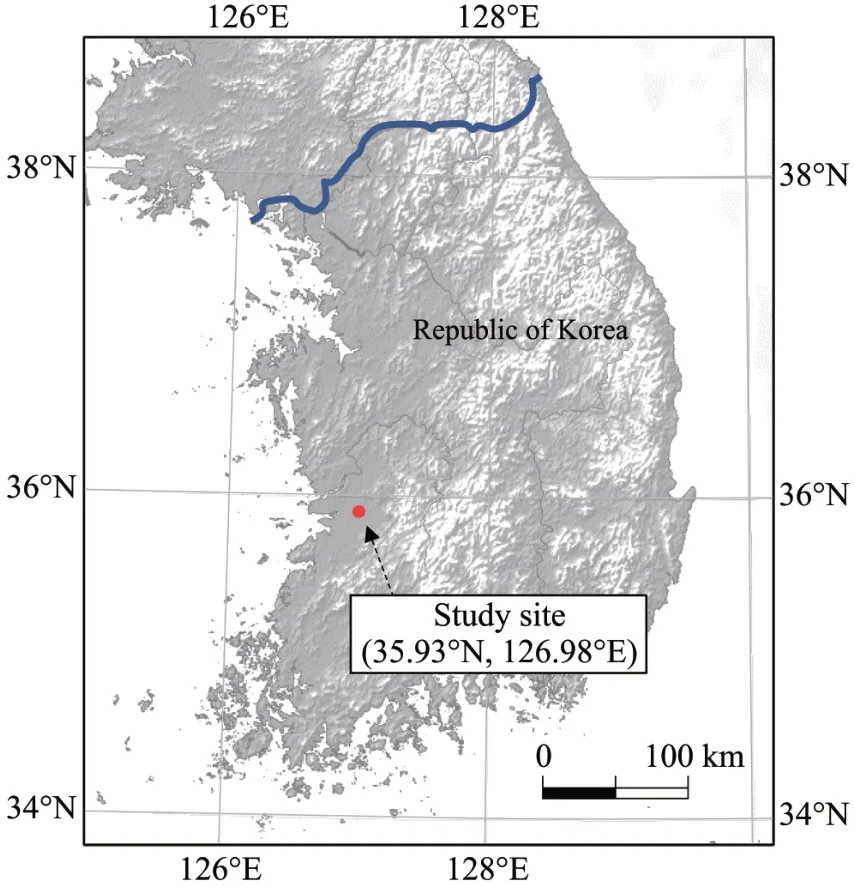
Figure 1 Field test location
2.2 Automated cone penetrometer(ACP)
ACP is a portable and rapid in-situ penetration method,which acquires the strength profile of the subgrade using theN-value(NACP).ACP consists of a cone tip,driving rod,and hydraulic motor hammer system,as shown in Figure 2.The diameter and apex angle of the cone tip are 35.6 mm and 60°,respectively,and it can be used disposably.The diameter of the driving rod was 20 mm so that the friction between the driving rod and soil can be minimized.Furthermore,the driving rod,which was 1 m long,can be extended using the thread connection.The weight and drop height of the hammer were 294.3 N and 200 mm,respectively;thus,the potential energy of the hammer was 58.9 N·m.The hammer was lifted using the hydraulic system.Therefore,the ACP automatically and rapidly penetrates the subgrade.NACPwas acquired by measuring the blow count for a penetration depth of 100 mm,which is similar to the N-value from SPT.
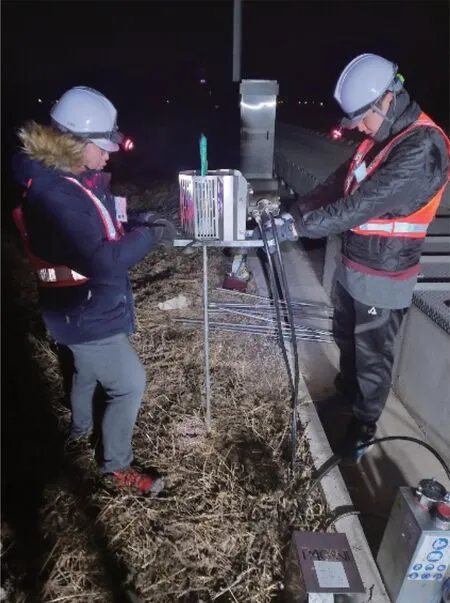
Figure 2 Field test on the railway subgrade using ACP
2.3 Dynamic cone penetrometer(DCP)
DCP is an extensively used conventional device for the strength profiling of the subgrade(ASTM D6951,2009).The DCP is composed of a cone tip,driving rod,anvil,and manual hammer system,as shown in Figure 3.The diameter and apex angle of the cone tip are 20 mm and 60°,respectively.Thus,the diameter of the cone tip is smaller than that of ACP.The diameter of the driving rod was 16 mm to reduce the friction between the driving rod and soil.Note that the difference of the diameter between the cone tip and driving rod in ACP is greater than that in DCP.The 1 m length of the driving rod of DCP can be extended,as in ACP.The weight and drop of the hammer were 78.5 N and 575 mm,respectively;thus,the potential energy of the hammer was 45.1 N·m.The hammer was lifted manually and allowed to fall freely for the penetration.The penetration depth of each blow,which is defined as DCPI,was manually measured and recorded.Thus,DCP can be applied for the shallow depth owing to the hand-operated hammer system and low potential energy.
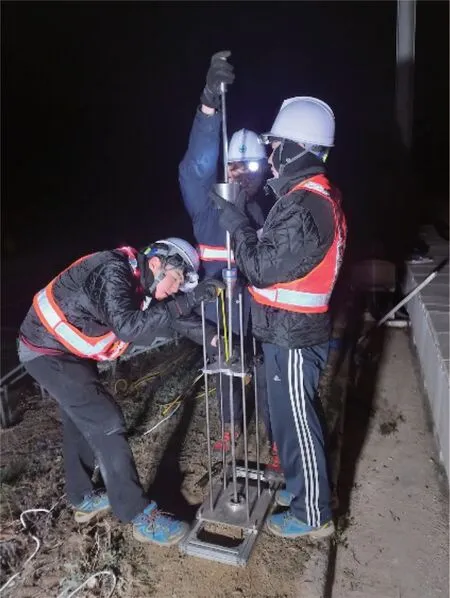
Figure 3 Field test on the railway subgrade using DCP
3 Test results and analyses
3.1 DCPI and NACP profiles
DCPI andN-value(NACP)are continuously measured for the strength profiling of the railway subgrade.Both DCP and ACP were applied on three points,as shown in Figure 4.Figure 4a shows that the DCPI value near the surface is high owing to the low confining stress.Thereafter,the DCPI value decreases as the penetration depth increases because the effective overburden stress increases gradually.The DCP test was ceased when the hard layer emerged.The general DCPI value at Point-A was greater than that at Points B and C.Thus,the penetration depth of Point-A is the deepest.
TheNACPprofiles for Points A,B,and C are plotted in Figure 4b.Figure 4b shows that theNACPnear the surface is almost zero.This is opposite to that of the DCPI profile.Thereafter,NACPat Points B and C increased because of the effective overburden stress,whereas that at Point-A was maintained at 10 blow counts/100 mm.TheNACPvalues in Figure 4b show less fluctuation than the DCPI values in Figure 4a because the resolution of DCP is higher than that of ACP.Note thatNACPcan be acquired each penetration depth of 100 mm.The generalNACPvalue at Point-A is lower than that at Points B and C.This corresponds to the DCPI profile shown in Figure 4a.

Figure 4 Typical test results:(a)DCPI;(b)NACP
3.2 Correlations
NACPwas correlated with DCPI to extend the applicability ofNACP,as shown in Figure 5.For the correlation,the DCPI of each penetration depth of 100 mm was adopted.This corresponds to the measured penetration depth ofNACP.The relationship of DCPI andNACPis expressed as a reciprocal function owing to the inverse concept of the unit,as shown in Equation(1).

Furthermore,1/DCPI is correlated withNACPto unify the unit,as shown in Figure 5b.1/DCPI shows a linearly proportional relationship withNACP.However,the maximum value of 1/DCPI is 1 blow/mm because the minimum manually measured DCPI is 1 mm/blow.Thus,four points of 1 blow/mm are out of the proportional relationship,as shown in Figure 5b.
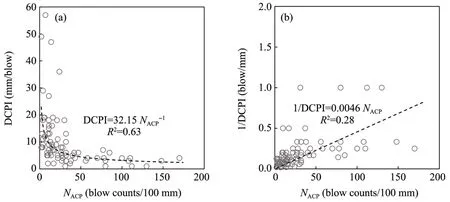
Figure 5 Correlation of strength indices:(a)DCPI vs.NACP;(b)1/DCPI vs.NACP
The relationship between DCPI and EFWD(Sawangsuriya and Edil,2005),as per the data obtained in this study,is plotted in Figure 6a.Thereafter,the relationship of DCPI is replaced withNACPusing Equation(1)for evaluatingEFWDbyNACP.The range of evaluatedEFWDfromNACP(Figure 6b)is greater than that from DCPI(Figure 6a)because of the limited measured DCPI of 1 mm/blow.Thus,NACPcan prevent the underestimation ofEFWD.Moreover,NACPcan be efficiently used for evaluatingEFWD.
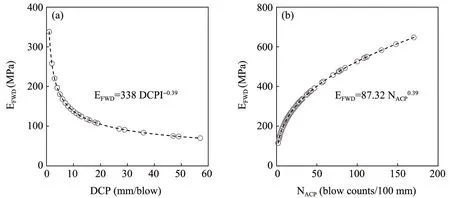
Figure 6 Correlation between strength and stiffness:(a)EFWD vs.DCPI;(b)EFWD vs.NACP
4 Conclusions
The objective of this study was to introduce ACP and applyNACPfor evaluating the strength and stiffness of the railway subgrade.The main observations from this study are as follows:
•ACP is more efficient than DCP in a field with low accessibility owing to the hydraulic hammer system and greater potential energy.
•NACPcan be used reliably for evaluating the strength and stiffness using the correlations.However,DCPI has a limitation owing to the minimum manually measured value of 1 mm/blow.
•NACPcan be alternatively applied for the strength profiling with higher speed and penetration capability rather than DCPI owing to its coverage for manually measuring method.
Acknowledgments:
This work was supported by the National Research Foundation of Korea(NRF)grant funded by the Korea government(MSIT)(No.NRF-2021R1A5A10324 33;NRF-2020R1A2B5B03001470).
 Sciences in Cold and Arid Regions2022年4期
Sciences in Cold and Arid Regions2022年4期
- Sciences in Cold and Arid Regions的其它文章
- The influence of the underpassing frozen connecting passage on the deformation of the existing tunnel
- Influence of freeze tube deviation on the development of frozen wall during long cross-passage construction
- Thermal-Hydro-Mechanical coupled analysis of unsaturated frost susceptible soils
- Frozen curtain characteristics during excavation of submerged shallow tunnel using Freeze-Sealing Pipe-Roof method
- Discussion on pile axial load test methods and their applicability in cold regions
- Triaxial test on glass beads simulating coarse-grained soil
